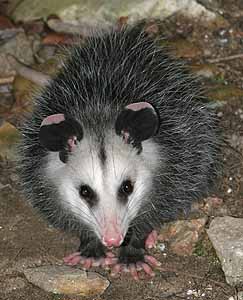 The Opossum
The Opossum
Didelphis marsupialis
The spark of life barely flickers in his brain. His ancestors walked in the shadow of dinosaurs and mingled with horses that grew only 12 inches tall. Slow, clumsy and low on the intelligence scale, the opossum is an ancient mammal and seems destined to follow us to the stars.
GENERAL CHARACTERISTICS
The adult opossum (Didelphis marsupialis) weighs about seven pounds.
It's face is elongate, narrow and coneshaped. The
opossum has black, hairless ears that are leathery in texture and
tipped in pink or white. Their tales are naked and scaly, and their
feet are shaped like hands. Dense underfur is white with grayish
tips, and the guard hairs are dark gray or black, but from a distance,
opossums appear grayish in color. Some individuals may have underfur
tipped in brown, and these animals will have a brownish cast rather
than gray. The opossum has black, beady eyes set in the whitish
head, and the feet are black with pink or white toes. The inner
toe of each hind foot is like a thumb. An albino variation is not
an uncommon sight. The albino varieties will have pink eyes, and
white ears and feet. The female opossum has a woolly pouch on her
abdomen for carrying and nourishing her newborn young. The skull
of the opossum belies its ancient lineage because it contains 50
teeth, the most of any US mammal.
REPRODUCTION
The breeding season for opossums begins in February. Young are born
within two weeks after mating. From 10 to 20 offspring leave the
birth canal and crawl to the female's pouch. Helpless and less
than an inch long, the offspring struggle to gain possession of
one of the 13 teats contained in the pouch. The successful young
remain attached to the teats for a month before they begin to leave
the pouch for short periods. As they continue to grow, they are
forced to abandon the pouch, and the mouse sized youngsters retreat
to the mother's back, often clinging to her tail as she wanders
in search of food. Litters are not produced at any particular time
but are born over a relatively long period from early spring into
summer. Females can produce two litters per year. The young remain
with the female for about three months. The final litter of the
season may be traveling with the female when the first litter of
the next year is born.
DISTRIBUTION AND ABUNDANCE
Opossums were once uncommon in northern portions of the United States.
In the past half-century, opossums have extended their range and
are now found in Canada. These animals occur in each county of Indiana,
but their numbers can be reduced in northern tier of counties due
to severe winter conditions. It is not uncommon to find individuals
with tips of their ears and tails blunted from frostbite following
a harsh winter.
 FOOD HABITS
FOOD HABITS
Aside from the overwhelming reproductive powers, a reason for opossum
survival is their ability to eat nearly anything, vegetable or animal,
in any state of decomposition. They serve as scavengers, thriving
on foods discarded or rejected by other animals. Opossums eat eggs
and young of fellow creatures and occasionally kill sleeping poultry
and ground nesting birds. These items are rounded out with nuts,
acorns, persimmons and corn. They do not hibernate, but amble forth
in search of food on cold, winter nights.
HUNTING
Few night hunters go out with their faithful hounds in search of
opossum. Some, however, are encountered in search of more appealing
game. Most opossums taken by hunters are harvested by raccoon or
fox hunters. Opossums have some value as furbearers, and a good
number are sold each year for their pelts. Those who have tried
eating roasted opossum find their flesh tasty, so some end up in
a roasting pan each season.
TRAPPING
Occasionally, opossums are captured during fur season in sets designed
for other furbearers. This is especially true if a strong smelling
lure or decayed meat is used as bait. Since little effort is required
in pelting opossum, most trappers add them to their trapline catch
as a bonus.
MANAGEMENT
Opossums, because of their wide variety of eating habits, do not
require special management techniques. Protection from hunting and
trapping during closed season enables them to continue to exist
at abundant levels. They have few natural predators. Dogs, foxes
and owls will prey upon them, but the opossum's reproductive
capabilities overcome any losses. Their slow travel pattern across
highways probably spells doom to more opossums than any other adversity.
The combined hunter/trapper take poses no threat to the statewide population.